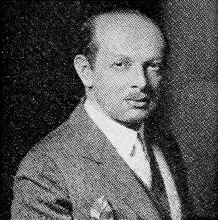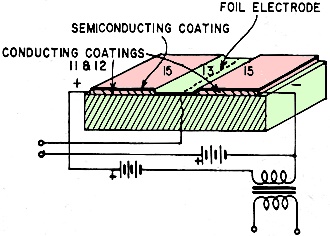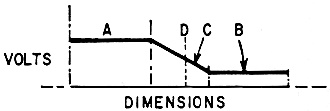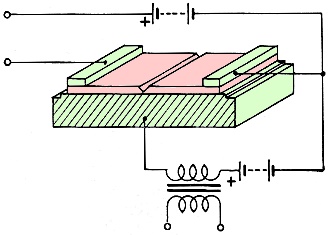|
December 1964 Radio-Electronics
 [Table of Contents] [Table of Contents]
Wax nostalgic about and learn from the history of early electronics.
See articles from Radio-Electronics,
published 1930-1988. All copyrights hereby acknowledged.
|
Here is yet more
evidence of my oft-made claim that Germany might have dominated the world as a
technological and financial superpower if it had not instigated two world wars.
A huge amount of ingenuity and ability to convert ideas into reality has come
out of Germany over the course of centuries. Oppressive and often inhumane
government behavior caused a lot of that talent to emigrate to other countries,
so the opportunity was lost. In this instance, I refer to Julius Edgar Lilienfeld,
who not only produced the first sample of liquefied helium, but also is
credited, according to this 1964 Radio-Electronics magazine article,
for developing the first semiconductor devices for amplification. U.S. patent
number US1745175A
was awarded on January 28, 1930 (filed on October 8, 1926) for what was
essentially a field effect transistor. Lilienfeld became a U.S. citizen in 1935.
To be fair, I will also note that many of those fled-to countries are today as
bad or worse than Germany was then.
Inventors of Radio: Julius Edgar Lilienfeld

Julius Edgar Lilienfeld, inventor of the solid-state amplifier.
By Fred Shunaman
In the early days of the century, in Leipzig, Germany, Julius Edgar Lilienfeld
attacked the problem of determining why hydrogen could not be liquefied. As one
result of his research, Lilienfeld produced the first liquid hydrogen.
Thus began the career of the man who appears to have developed the first semiconductor
devices for amplification. Working in the United States on electrolytic capacitors,
Dr. Lilienfeld apparently learned much of the nature of conducting and semiconducting
compounds, resulting in three patents covering solid-state electric amplifiers.
His first patent (No. 1,745,175) describes a "Method and apparatus for controlling
electric current." This device consisted of a substrate of glass or other material
on top of which two conducting members, "gold, silver, or copper," called 11 and
12 in Fig. 1, a copy of his patent, were placed so that their edges would be very
close together. Between the two edges, another electrode of metal foil (13) is juxtaposed
in such a way that its upper edge lies flush with the upper surface of the glass.
Over the conducting members and the glass between them a film of "copper and sulfur"
(presumably cuprous sulfide) is deposited, either chemically or by sputtering or
evaporation.

Fig. 1 - Lilienfeld's first solid-state patent.

Fig. 2 - Representation of energy levels in the drawing of Fig.
1.

Fig. 3 - A later modification of the device "for controlling
electric current."
The theory of the device, as given by the inventor, is that, if one of the connecting
plates is held at a higher and the other at a lower voltage, there will be a voltage
gradient across the semiconducting layer. As indicated in Fig. 2, a may be considered
the voltage of Plate 11, b that of Plate 12, and c the drop across semiconducting
layer 15. Varying the voltage on b (13 in Fig. 1) varies the impedance to the flow
of electrons from 11 to 12, making it possible for the smaller amount of power in
the circuit connected to element 13, which would nowadays be called the "base",
to control the larger amount of power in the circuit connected to 11 and 12. The
patent shows a radio set, with two of these devices hooked up as rf amplifiers,
and two as af amplifiers, with a speaker output. We have found no evidence that
such a set was ever constructed, and some doubt has been expressed as to whether
the amplifier would work at radio frequency.
Another patent, No. 1,877,140, Sept. 13, 1932, is called "Amplifier for electric
currents," and a third one, No. 1,900,008, Mar. 7, 1933, appears to be a refinement
of the original one with the two conducting plates. A single plate of what is described
in the patent as copper sulfide rests on a layer of aluminum oxide, which forms
the surface of an aluminum substrate. A transverse notch, which, according to the
patent, has to reduce the thickness of the top layer to a degree "approaching molecular
thickness" is provided, and the "base" contact is simply made to the aluminum block
(Fig. 3).
There is some doubt about just how these devices should be classified: as a kind
of transistor, or some other type of solid-state amplifier? There is no doubt, however,
that Dr. Lilienfeld did invent the first solid-state amplifier of record.
His wife, writing from the Virgin Islands, where Lilienfeld made his home after
becoming a citizen of the United States in 1935, states: "His laboratory in Leipzig
was a mecca for all interested in high-vacuum, low-temperature work. His X-ray tubes
were the first anywhere to be used by the medical profession, and were manufactured
in quantity by Koch & Stossel in Dresden."1
Before leaving Germany (apparently in the early 20's), he also made important
discoveries in field emission. These were actual steps on the road toward the field
electron microscope.2 One worker in that area3 believes the
discoveries reflected a Lilienfeld influence on most field-emission work up to the
present.
1 Science Fortnightly, P. Lorillard Research Laboratories, April 29, 1964
2 Müller, Dr. Erwin W., "Practical Field Electron Microscope," Radio-Electronics,
September 1951, page 43
3 J. B. Johnson, "More on the Solid-State Amplifier and Dr. Lilienfeld," Physics
Today, May 1964
Posted February 20, 2024
|












